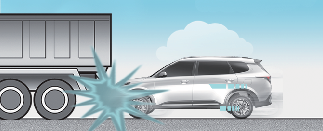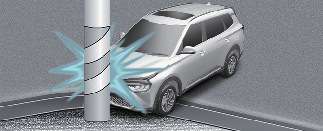Airbag non-inflation conditions
|
Airbag non-inflation conditions |
|
|---|---|
 |
In certain low-speed collisions the airbags may not deploy. |
 |
Airbags are not designed to inflate in rear collisions. |
 |
Heavy braking lowers the front portion of the vehicle causing it to "ride" under a vehicle with a higher ground clearance. Airbags may not inflate in this "under-ride" situation because deceleration forces that are detected by sensors may be significantly reduced by such "under-ride" collisions. |
 |
In an angled collision, the force of impact may send the occupants in a direction where the airbags would not be able to provide any additional benefit; thus, the sensors may not deploy any air bags. |
 |
Front airbags may not inflate in side impact collisions. However, if equipped with side and curtain airbags, the airbags may inflate depending on the intensity, vehicle speed and angles of impact. |
 |
Airbags may not inflate in rollover accidents because the vehicle cannot detect the rollover. |
 |
Airbags may not inflate if the vehicle collides with objects such as utility poles or trees, meaning the point of impact is concentrated in one area and the full force of the impact is not delivered to the sensors. |

-
The SRS is designed to deploy the front airbags only when an impact is sufficiently severe and when the impact angle is less than 30° from the forward longitudinal axis of the vehicle.
-
Front airbags are not intended to deploy in side-impact, rear-impact or rollover crashes. In addition, front airbags will not deploy in frontal crashes below the deployment threshold.
-
The airbags deploy only in certain side impact or rollover conditions severe enough to cause significant injury to the vehicle occupants.
-
Deactivate the passenger's front airbag only when the ignition switch or ENGINE START/STOP button is switched off, or the malfunction may occur in the SRS Control Module. And there may be a danger that the driver's and/or front passenger's and/or side and curtain airbag may fail to trigger, or not trigger correctly during a collision.
-
Do not hit or allow any objects to impact the locations where airbag or sensors are installed. This may cause unexpected airbag deployment, which could result in serious personal injury or death.
-
If the installation location or angle of the sensors in altered in any way, the airbags may deploy when they should not or they may not deploy when they should, causing severe injury or death. Therefore, do not try to perform maintenance on or around the airbag sensors. Have the system serviced by a professional workshop. Kia recommends that you visit an authorised Kia dealer/service partner.
-
Your vehicle has been designed to absorb impact and deploy the airbag(s) in certain collisions. Installing bumper guards or replacing a bumper with non-genuine parts may adversely affect your vehicle collision and airbag deployment performance.
-
If an airbag deploys, there may be a loud noise followed by a fine dust released in the vehicle. These conditions are not hazardous.
-
The airbags are packed in this fine power. The dust generated during airbag deployment It may cause skin or eye irritation as well as aggravate asthma for some persons. Always wash all exposed skin areas thoroughly with cold water and a mild soap after an accident in which the airbags were deployed.
-
For cleaning the airbag pad covers, use only a soft, dry cloth or one which has been moistened with plain water.
-
Solvents or cleaners could adversely affect the airbag covers and proper deployment of the system.
-
Keep the SRS parts and wirings away from water or any liquid. If the SRS components are inoperative due to exposure to water or liquids, it may cause fire or severe injury.
-
If any of the following conditions occurs, this indicates a malfunction of the SRS. In this case, have the system inspected by a professional workshop. Kia recommends that you visit an authorised Kia dealer/service partner.
-
The light does not turn on briefly when you turn the ignition ON.
-
The light stays on after illuminating for approximately 6 seconds.
-
The light comes on whilst the vehicle is in motion.
-
The light blinks when the ignition switch or ENGINE START/STOP button is in ON position.
-
-
Before you replace a fuse or disconnect a battery terminal, turn the ignition switch or ENGINE START/STOP button to the LOCK position and remove the ignition key or turn off the ENGINE START/STOP button. Never remove or replace the airbag related fuse(s) when the ignition switch or ENGINE START/STOP button is in the ON position. Failure to heed this warning will cause the SRS airbag warning light to appear.
-
Do not tamper with or disconnect wiring or other components of the SRS system, including the addition of any kind of badges to the pad covers or modifications to the body structure. Doing so could adversely affect SRS performance and lead to possible injury. If necessary, have the system serviced by a professional workshop. Kia recommends that you visit an authorised Kia dealer/service partner.
-
If your car was flooded and has soaked carpeting or water on flooring, you shouldn't try to start the engine; in this case, have your vehicle inspected by a professional workshop. Kia recommends that you contact an authorised Kia dealer/service partner.
-
Airbags can only be used once. If the airbags inflate, have the system replaced by a professional workshop. Kia recommends that you visit an authorised Kia dealer/service partner.
-
If components of the airbag system must be discarded, or if the vehicle must be scrapped, certain safety precautions must be observed, such as removing SRS and pre-tensioners from a vehicle due to the risk of fire. Failure to follow these precautions and procedures could increase the risk of personal injury. An authorised Kia dealer knows these precautions and can give you the necessary information.

However, side and/or curtain airbags may inflate when the vehicle is rolled over by a side impact collision, if the vehicle is equipped with side airbags and curtain airbags.